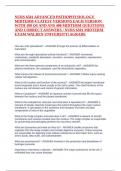NURS 6501 ADVANCED PATHOPHYSIOLOGY
MIDTERM 4 LATEST VERSIONS EACH VERSION
WITH 100 QS AND ANS 400 MIDTERM QUESTIONS
AND CORRECT ANSWERS / NURS 6501 MIDTERM
EXAM WALDEN UNIVERSITY| AGRADE
How are cells specialized? - ANSWER through the process of differentiation or
maturation
What are the eight specialized cellular functions? - ANSWER movement,
conductivity, metabolic absorption, secretion, excretion, respiration, reproduction,
and communication
What are the three general components of an eukaryotic cell? - ANSWER the
plasma membrane, the cytoplasm, and the intracellular organelles.
What causes the release of lysosomal enzemes? - ANSWER Cellular injury causing
cellular self-digestion
What is the location and function of the nucleus? - ANSWER the largest membrane-
bound organelle and is found usually in the cell's center. The chief functions of the
nucleus are cell division and control of genetic information.
What is Cytoplasm? - ANSWER an aqueous solution (cytosol) that fills the space
between the nucleus and the plasma membrane.
What is the endoplasmic reticulum and what does it specialize in? - ANSWER a
network of tubular channels (cisternae) that extend throughout the outer nuclear
membrane. It specializes in the synthesis and transport of protein and lipid
components of most of the organelles
What is the Golgi complex and what does it do? - ANSWER a network of smooth
membranes and vesicles located near the nucleus. The Golgi complex is responsible
for processing and packaging proteins into secretory vesicles
What are lysosomes and what do they do? - ANSWER saclike structures that
originate from the Golgi complex and contain digestive enzymes. These enzymes
are responsible for digesting most cellular substances to their basic form, such as
amino acids, fatty acids, and carbohydrates
What are peroxisomes? - ANSWER involved in the production and breakdown of
hydrogen peroxide
Importance of proteins in disease - ANSWER The major workhorses of the cell, if
misfolded they can cause diseases
, What are mitochondria responsible for? - ANSWER . Mitochondria contain the
metabolic machinery necessary for cellular energy metabolism (Makes ATP).
What is the cytoskeleton? - ANSWER the "bone and muscle" of the cell. The internal
skeleton is composed of a network of protein filaments, including microtubules and
actin filaments (microfilaments).
What is the plasma membrane? - ANSWER encloses the cell and, by controlling the
movement of substances across it, exerts a powerful influence on metabolic
pathways
What is signal transduction? - ANSWER The transfer of molecular signals from the
exterior to the interior of a cell. If not done apoptosis occurs
What is protein regulation and what is it composed of? - ANSWER protein
homeostasis and is defined by the proteostasis network. This network is composed
of ribosomes (makers), chaperones (helpers), and protein breakdown or proteolytic
systems. Malfunction of these systems is associated with disease.
What do protein receptors do? - ANSWER on the plasma membrane, enable the cell
to interact with other cells and with extracellular substances
What means accomplish cell-to-cell adhesions? - ANSWER (1) the extracellular
membrane, (2) cell adhesion molecules in the cell's plasma membrane, and (3)
specialized cell junctions.
What makes up the extracellular matrix and what does it do? - ANSWER (1) fibrous
structural proteins (collagen and elastin), (2) adhesive glycoproteins, and (3)
proteoglycans and hyaluronic acid. The matrix helps regulate cell growth, movement,
and differentiation.
How do cells communicate? - ANSWER (1) they form protein channels (gap
junctions); (2) they display receptors that affect intracellular processes or other cells
in direct physical contact; and (3) they use receptor proteins inside the target cell.
How is intercellular signaling done? - ANSWER contact-dependent, paracrine,
hormonal, neurohormonal, and neurotransmitter.
What is ATP? - ANSWER Adenosine Triphosphate - ENERGY - is required for active
transport.
What is anabolism? - ANSWER energy-using process of metabolism
What is catabolism? - ANSWER the energy-releasing process of metabolism
What is passive transport? - ANSWER The movement of materials across the cell
membrane without using cellular energy, water and small electrically uncharged
molecules, done through osmosis




